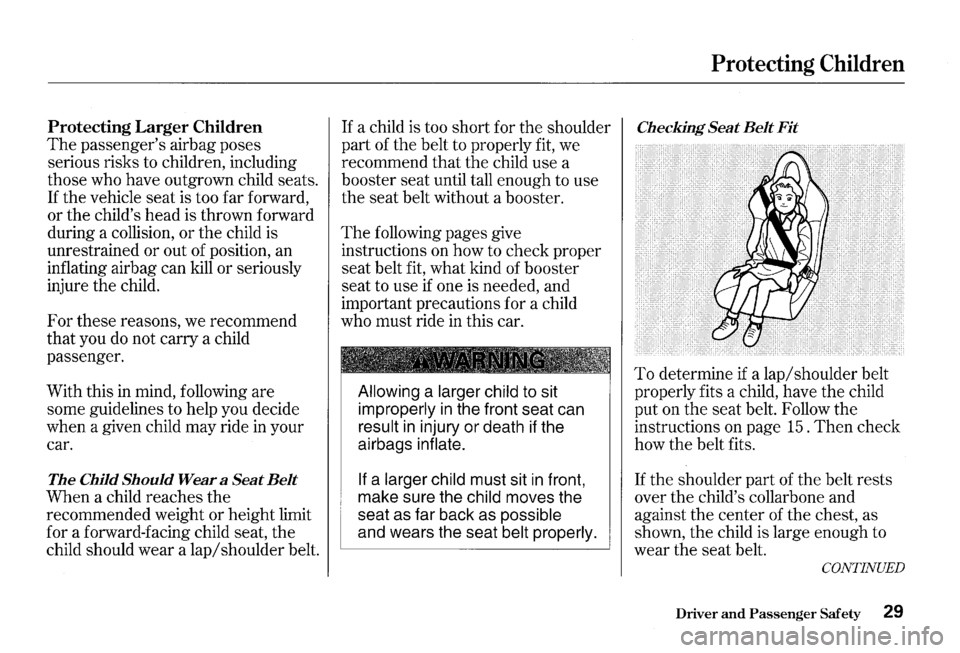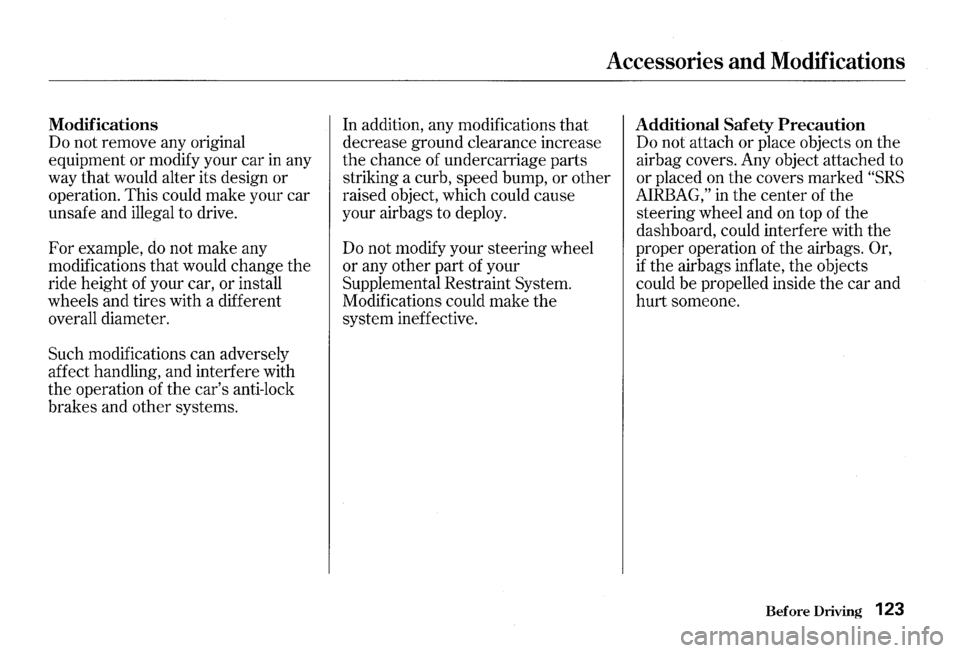2000 HONDA S2000 airbag
[x] Cancel search: airbagPage 32 of 273

Protecting Larger Children
The passenger's airbag poses
serious risks to children, including
those who have outgrown child seats.
If the vehicle seat is too far forward,
or the child's head is thrown forward
during a collision, or the child is
unrestrained or out of position, an
inflating airbag can kill or seriously
injure the child.
For these reasons, we recommend
that you
do not carry a child
passenger.
With this
in mind, following are
some guidelines to help you decide
when a given child may ride in your
car.
The Child Should Wear a Seat Belt
When a child reaches the
recommended weight or height limit
for a forward-facing child seat, the
child should wear a lap/shoulder belt.
If a child is too short for the shoulder
part of the belt to properly fit, we
recommend that the child use a
booster seat until tall enough to use
the seat belt without a booster.
The following pages give
instructions on how to check proper
seat belt fit, what kind of booster
seat to use
if one is needed, and
important precautions for a child
who must ride in this car.
Allowing a larger child to sit
improperly in the front seat can
result in injury or death if the
airbags
inflate.
If
a larger child must sit in front,
make sure the
child moves the
seat as far back as
possible
and wears the seat belt properly.
Protecting Children
Checking Seat Belt Fit
To determine if a lap/shoulder belt
properly fits a child, have the child
put on the seat belt. Follow the
instructions on page 15.
Then check
how the belt fits.
If the shoulder part of the belt rests
over the child's collarbone and
against the center of the chest, as
shown, the child is large enough to
wear the seat belt.
CONTINUED
Driver and Passenger Safety 29
Page 38 of 273

SRS Components
Your Supplemental Restraint System
(SRS) includes:
• Two front airbags. The driver's
airbag is stored
in the center of
the steering wheel; the front
passenger's airbag is stored
in the
dashboard. Both are marked
"SRS
AIRBAG."
•
Automatic seat belt tensioners
that tighten
the front seat belts
during a moderate to severe
frontal collision.
• Sensors that can detect a
moderate to severe frontal
collision.
• A sophisticated electronic system
that continually monitors the
sensors, control unit, the airbag
activators, and all related wiring
when the ignition is
ON (II).
Additional Information About Your SRS
• An indicator light on the How Your Airbags Work
instrument panel that alerts you to
a possible problem with the
system (see page
37).
• Emergency backup power in case
your car's electrical system
is
disconnected in a crash.
If you ever have a moderate to
severe frontal collision, the sensors
will detect rapid deceleration and
signal the control unit to instantly
inflate the airbags and activate the
automatic seat belt tensioners.
CON11NUED
Driver and Passenger Safety 35
Page 39 of 273

Additional Information About Your SRS
During a crash, your seat belt helps
restrain your lower body and torso,
while the tensioner tightens and
locks
the seat belt to help keep you
in place.
Your air bag provides a
cushion to help restrain and protect
your head and chest.
Since both airbags use the same
sensors, both airbags normally
inflate at the same time. However, it
is possible for only one air bag to
inflate.
This can occur when the severity of
a collision is at the margin, or
threshold, that determines whether
or not the airbags will deploy. In
such cases, the seat belt will provide
sufficient protection, and the
supplemental protection offered by
the air bag would be minimal.
36 Driver and Passenger Safety
Mter inflating, the airbags
immediately deflate, so they won't
interfere with the driver's visibility,
or the ability to
steer or operate
other controls.
The total time for inflation and
deflation is approximately one-tenth
of a second, so fast
that most
occupants are not aware that the
airbags deployed until they see
them
lying in their laps.
Mter a crash, you may see what
looks like smoke. This is actually
powder from the airbag's surface.
Although the powder is not harmful,
people with respiratory problems
may experience some temporary
discomfort.
If this occurs, get out of
the car as soon as it is safe to
do so.
U.S. Owners
For additional information on how
your airbags work, see the booklet
titled
SRS· What You Need to Know
About Airbags that came with your
owner's manual.
Canadian Owners
For additional information on how
your airbags work, ask your dealer
for a copy of the booklet titled
SRS:
What
You Need to Know About Airbags.
Page 40 of 273

How the Automatic Seat Belt
Tensioners Work
Your Honda has automatic seat belt
tensioners for added protection
during a moderate to severe frontal
collision.
If your airbags inflate, the tensioners
immediately tighten the front
seat
belts to help hold the occupants in
place.
The belts will remain tight
until you unbuckle
them in the
normal way.
Additional Information About Your SRS
How the SRS Indicator Light
Works
~ ~he J?Urpose of the SRS
~ hght 1s to alert you to a
potential problem with your
Supplemental Restraint System.
When you turn the ignition
ON (II),
this indicator will light up briefly
then go out. This tells you that the
system is working properly.
However,
if the light comes on at any
other time, you should have the
system checked by your dealer. For
example:
• If the SRS indicator light does not
come on after you turn the ignition
ON(II).
• If the light stays on after the
engine starts.
• If the light comes on or flashes on
and off while you drive.
If you see any of these indications,
your airbags and
seat belt tensioners
may not deploy when you need them.
See your Acura dealer as soon as
possible.
Ignoring the SRS indicator light
can result in serious injury or
death if the airbags do not
inflate when needed.
Have your
vehicle checked by a
dealer as soon as possible if
the SRS
light alerts you to a
potential problem.
Driver and Passenger Safety 37
Page 41 of 273

Additional Information About Your SRS
SRSService
Your Supplemental Restraint System
is virtually maintenance-free, and
there are no parts you can safely
service. However, you must have
your car serviced
if:
• Your airbags ever inflate. The
airbags, seat belt tensioners, and
control unit must be replaced.
Do
not try to remove or replace the
airbags yourself.
This must be done by a Honda
dealer or a knowledgeable body
shop.
• The SRS indicator light alerts you
to a problem. Take your car to an
authorized Honda dealer as soon
as possible.
If you ignore this
indication, the airbags might not
inflate when you need
them (see
page
45 ).
38 Driver and Passenger Safety
Additional Safety Precautions
• Do not attempt to deactivate your
airbags. Together, airbags and
seat belts provide the best
protection
in a moderate to severe
frontal collision.
• Do not tamper with SRS
components or wiring for any
reason. Tampering could cause
the airbags to deploy, possibly
causing very serious injury.
See page 123 for further information
and precautions relating to your
SRS.
Page 43 of 273

Safety Labels
These labels are in the locations
shown.
They warn you of potential
hazards that could cause serious
injury. Read these labels carefully.
If a label comes off or becomes hard
to read, contact your Honda dealer
for a replacement.
DASHBOARD U.S. models only
A WARNING
Children Can Be KILLED or INJURED by Passenger Air Bag Male sure all ctilcran use aeatbalts or~ild seata
40 Driver and Passenger Safety
SUN VISOR
U.S. models
Canadian models
SEAT BELT TENSIONER
I ... "·'·"''""" I ... ~iEUl1>11 I UrLOIIH "'•[OIH '""'"' ~"'"'""'lOS I' o l'oN""""" ..... , ..... , ... , ......... , .. _ , .... , ............. , ........... . •Do ,., "~'" " ""'"~'" ""' "" .,.,,. •• ''"""" '"" '" ··-...... ~ .. """ •h••'"-"' "~"'" ~;··;;;;;;;;:·:7 .. ·.:~··· :~;::;~::;;;;;::;:::::·;:::~:~::~:~~···
BATTERY
SUPPLEMENTAL RESTRAINT SYSTEM (SRS)@ ~~~'-------=::_'7=~i-Y~~----I This vehlclf Is equipped with driver and front seal passenger airbags All S RS electrical wir1ng and con 1ecto rs ore co I or ed ~ell ow. Tamoering wit~, disconnecting or using e I ec ~~ i ca I test equIpment on the S R S wl rln g can maXe the syslem inoperatiH or cause Hcidentat firing of th inflator A WARNING The alrbag Inflator Is uplosive and, II a c c ide r.t a II y de p I o ~ e d, can serious I y h urI 'IOU Fc',lcw Service Manual instructions caretulll'·
Page 125 of 273

Accessories and Modifications
Modifying your car, or installing
some non-Honda accessories, can
make your car unsafe. Before you
make any modifications or add any
accessories, be sure to read the
following information.
Accessories
Your dealer has Genuine Honda
accessories that allow you to
personalize your car.
These
accessories have been designed and
approved for your car, and are
covered by warranty.
Non-Honda accessories are usually
designed for universal applications.
Although aftermarket accessories
may fit on your car, they may not
meet factory specifications, and
could adversely affect your car's
handling and stability. (See
"Modifications" on the page 123 for
additional information.)
122 Before Driving
Improper accessories or
modifications can affect your
car's
handling, stability and
performance, and cause a
crash
in which you can be hurt
or
killed.
Follow all
instructions in this
owner's
manual regarding
accessories and modifications.
When properly installed, cellular
phones, alarms, two-way radios, and
low-powered audio systems should
not interfere with your car's
computer-controlled systems, such
as the
SRS and anti-lock brake
system. However,
if electronic
accessories
are improperly installed, or exceed
your car's electrical system capacity,
they can interfere with the operation
of your car, or even cause the
airbags to deploy.
Before installing any accessory:
• Make sure the accessory does not
obscure any lights,
or interfere
with proper car operation or
performance.
• Be sure electronic accessories do
not overload electrical circuits
(see page 231).
• Have the installer contact your
Honda dealer for assistance before
installing any electronic accessory.
If possible, have your dealer inspect
the final installation.
Page 126 of 273

Modifications
Do not remove any original
equipment or modify your car in any
way
that would alter its design or
operation. This could make your car
unsafe and illegal to drive.
For example, do not make any
modifications
that would change the
ride height of your car, or install
wheels and tires with a different
overall diameter.
Such modifications can adversely
affect handling, and interfere with
the operation of the car's anti-lock
brakes and other systems.
Accessories and Modifications
In addition, any modifications that
decrease ground clearance increase
the chance of undercarriage parts
striking a curb, speed bump, or other
raised object, which could cause
your airbags to deploy.
Do not modify your steering wheel
or any other part of your
Supplemental Restraint System.
Modifications could make the
system ineffective. Additional Safety Precaution
Do not attach or place objects on the
airbag covers. Any object attached to
or placed on the covers marked
"SRS
AIRBAG," in the center of the
steering wheel and on top of the
dashboard, could interfere with the
proper operation of the airbags.
Or,
if the airbags inflate, the objects
could be propelled inside the car and
hurt someone.
Before Driving 123